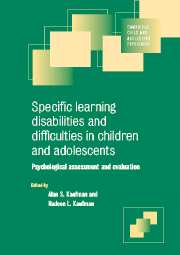 Specific Learning Disabilities and Difficulties in Children and Adolescents
Specific Learning Disabilities and Difficulties in Children and Adolescents Book contents
- Frontmatter
- Contents
- List of contributors
- Preface
- Part I History and Tradition
- Part II Alternative Cognitive Approaches to Learning Disabilities Assessment and Remediation
- 3 Application of the Woodcock—Johnson Tests of Cognitive Ability—Revised to the diagnosis of learning disabilities
- 4 The Kaufman tests — K-ABC and KAIT
- 5 Using the Cognitive Assessment System (CAS) with learning-disabled children
- 6 Application of the Differential Ability Scales (DAS) and British Ability Scales, Second Edition (BAS II), for the assessment of learning disabilities
- 7 Is dynamic assessment compatible with the psychometric model?
- 8 Multi-perspective, clinical—educational assessments of language disorders
- Part III Neuropsychological Approaches to Learning Disabilities Assessment and Remediation
- Part IV Integration and Summation
- Index
8 - Multi-perspective, clinical—educational assessments of language disorders
from Part II - Alternative Cognitive Approaches to Learning Disabilities Assessment and Remediation
Published online by Cambridge University Press: 06 January 2010
- Frontmatter
- Contents
- List of contributors
- Preface
- Part I History and Tradition
- Part II Alternative Cognitive Approaches to Learning Disabilities Assessment and Remediation
- 3 Application of the Woodcock—Johnson Tests of Cognitive Ability—Revised to the diagnosis of learning disabilities
- 4 The Kaufman tests — K-ABC and KAIT
- 5 Using the Cognitive Assessment System (CAS) with learning-disabled children
- 6 Application of the Differential Ability Scales (DAS) and British Ability Scales, Second Edition (BAS II), for the assessment of learning disabilities
- 7 Is dynamic assessment compatible with the psychometric model?
- 8 Multi-perspective, clinical—educational assessments of language disorders
- Part III Neuropsychological Approaches to Learning Disabilities Assessment and Remediation
- Part IV Integration and Summation
- Index
Summary
History, development, and assessment objectives
Assessment and intervention paradigms
The intention of this chapter is to present selected issues associated with the assessment of primary language disorders and language-based learning disabilities, and to discuss a multi-perspective assessment process for obtaining and interpreting language test results. In these discussions, there are assumptions and premises. The first is that to implement equitable assessments of language and communication in today's global society, multi-cultural and multilinguistic factors must be considered. Secondly, the process must embrace multi-dimensional and multi-perspective approaches. The use of norm-referenced and standardized tests is considered to be an integral component of multi-perspective assessment. The instruments should be complemented by naturalistic and authentic procedures. The objectives of a multi-dimensional and multi-perspective assessment process are many. One objective, however, stands out. It is to arrive at interpretations and decisions that reflect educational and social, as well as clinical perspectives.
In the USA, the inclusion movement (Will, 1986; Biklen, 1992) provided a forceful impetus for collaboration among regular and special educators, such as speech—language pathologists. Public Law 94–142 started this movement by mandating that special education services should be provided in the least restrictive environment. As a result, students with language disorders have been integrated in regular education classrooms with adequate and appropriate support from teachers, specialists, and related services.
- Type
- Chapter
- Information
- Specific Learning Disabilities and Difficulties in Children and AdolescentsPsychological Assessment and Evaluation, pp. 247 - 280Publisher: Cambridge University PressPrint publication year: 2001
- 3
- Cited by
